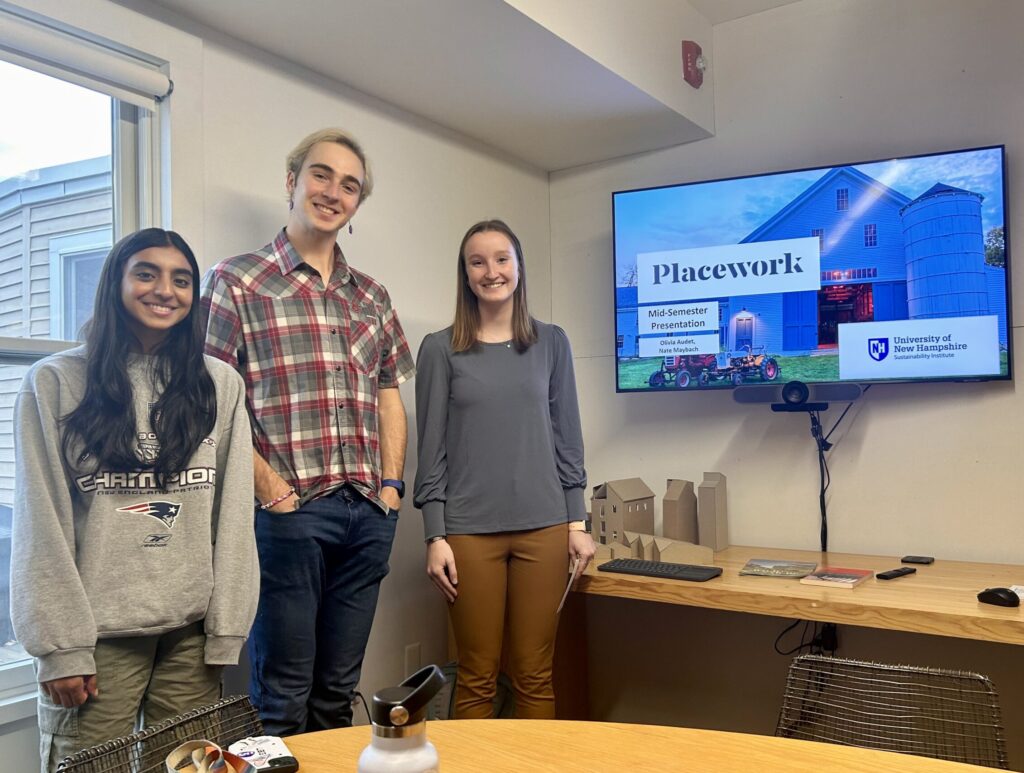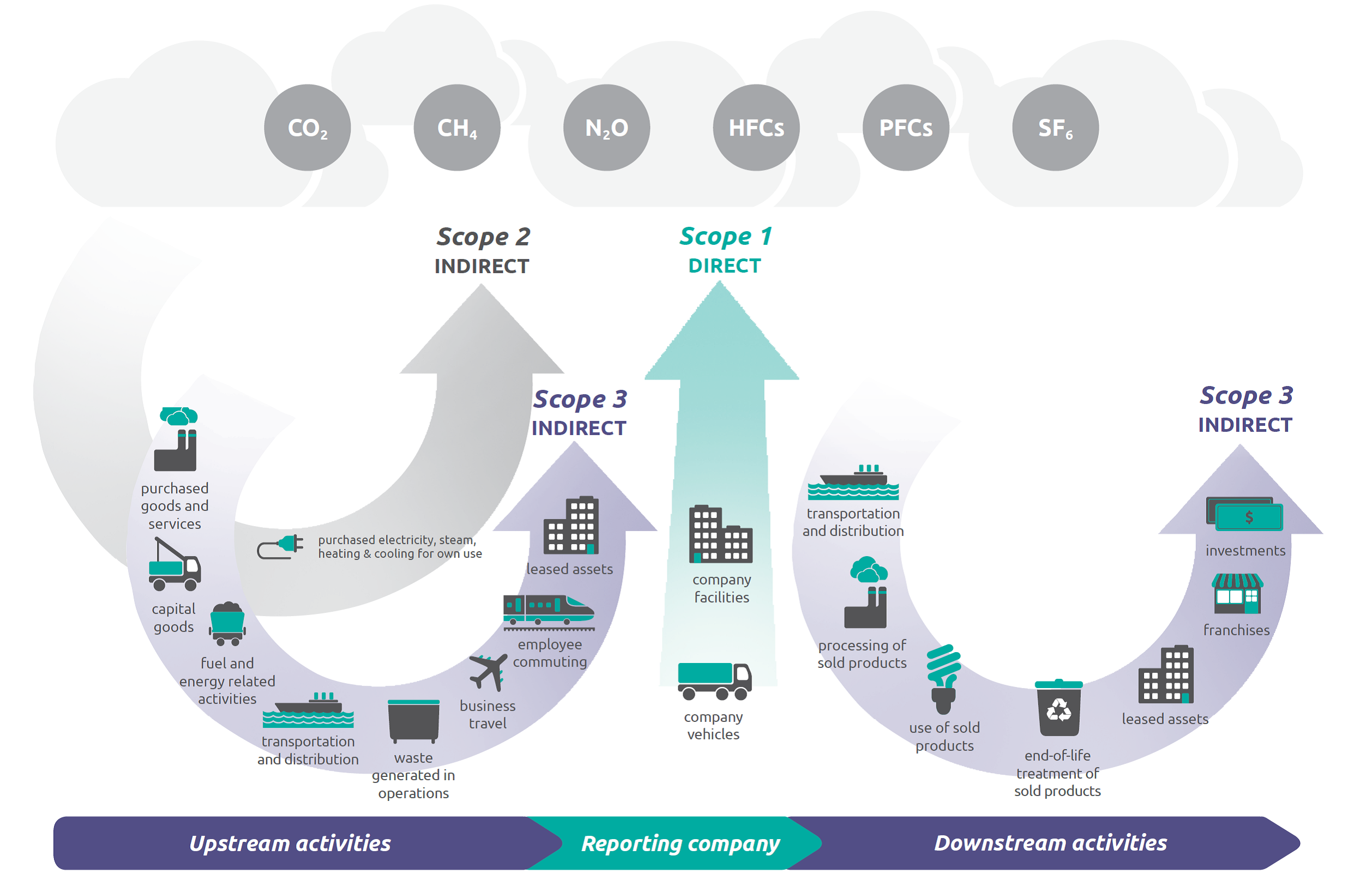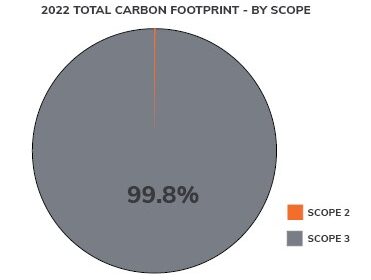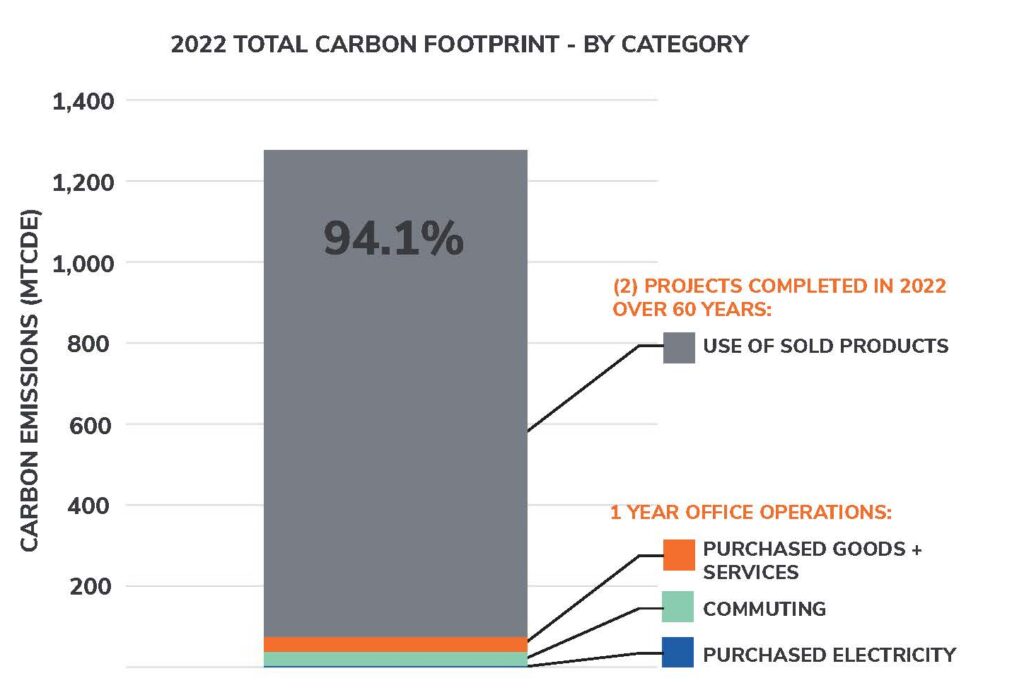Climate Action Clinic
December 15, 2023
We worked with a team of UNH students to establish a baseline carbon footprint.

Our team – Olivia Audet ’25, Nate Maybach ’25 and Peer Mentor Durga Raga ’25 – visited our office to present their work.
The UNH Sustainability Institute’s Climate Action Clinic offers students experience in greenhouse gas emissions accounting; it’s an opportunity for students to work directly with businesses on creating a carbon footprint analysis. This semester we’ve had the great pleasure of working with three students through this innovative program. We’ve been tracking various aspects of our carbon footprint for years but jumped at the opportunity to use a standardized process to quantify a complete greenhouse gas inventory.
We knew intuitively that our business operations have a very small footprint. But the buildings that we design – both the energy that they use and the materials they are made of – have a tremendous impact. We were unsure how to account for our designs — and learned that we were not alone. A common method for assigning responsibility for carbon in the building sector has only recently been established, and even had the opportunity to provide input on that policy.
The Basics
The first step in the process was establishing boundaries – a standard way to define the parameters for measurement. We decided to measure the 2022 emissions of the locations in which we operate and that we would review all Scope 1, 2 and 3 emissions.
 Source: WRI/WBCSD Corporate Value Chain (Scope 3) Accounting and Reporting Standard (PDF)
Source: WRI/WBCSD Corporate Value Chain (Scope 3) Accounting and Reporting Standard (PDF)
Another important baseline is the unit of measurement. As is common for universities and businesses, the greenhouse gas emissions inventory or “carbon footprint” is expressed in MTCDE: metric ton of carbon dioxide equivalent.
The Process
The student team used a tool called SIMAP, or the Sustainability Indicator Management and Analysis Platform. SIMAP is a carbon and nitrogen-accounting platform that is used to track, analyze, and improve sustainability. It was developed at UNH and is now the standard tool used by more than 500 universities and businesses across the country.

Its algorithms are based on two decades of research and use methodologies and emissions factors based on the Greenhouse Gas Protocol.
Because we don’t have any Scope 1 emissions and our Scope 2 was easily quantified by reviewing our electricity bill, most of the semester was spent analyzing our Scope 3 data.
Scope 3 includes twelve categories, including purchased goods and services, employee commuting, and waste.
Architects are responsible for reporting emissions from their projects for the next sixty years – compressed into the one year.
Evolving Guidance
The most complicated issue in our greenhouse gas inventory is the Use of Sold Products category. Our “sold products” are our designs, which affect buildings far into the future. Until this point, there has not been clear guidance on how architects should take responsibility for these emissions in their own carbon accounting. Just this year, however, the Science Based Targets initiative (SBTi) – an international effort aimed at encouraging and assisting companies in setting and achieving science-based climate targets – issued new draft guidance on accounting for Scope 3 emissions in the building sector.
The new guidance is the first clear direction on which party (owner, architect, engineer, builder) should be including which emissions in their own GHG reporting. Per the SBTi, architects are responsible for reporting emissions from their projects for the next sixty years – compressed into one year.
The draft guidance left the student team with some questions, so they reached out to the program coordinator at SBTi and were able to clarify some issues and refer to even newer updated guidance which was released on November 21st, just two weeks before the final presentation.
The Results
As we anticipated, the vast majority of our Scope 3 emissions – 94% – are due to the emissions of our designed buildings. The remaining 6% were almost evenly split between commuting and Purchased Goods/Services. Within Purchased Goods, the team broke down our 2022 total to identify potential reductions. Three areas identified for reduction were air travel, shifting our commuting to hybrid or EV vehicles, and purchasing renewable energy.
An interesting take away was that although we only took three flights in 2022, the carbon emissions are almost equivalent to our purchased energy for the entire year!

The most important reduction goal is clearly the energy use of our designed projects. As signatories to the AIA 2030 Commitment, we have already committed to design net-zero energy use on all of our projects by 2030. We have been tracking our reductions and making progress, but we’ve also learned that it’s not always possible, especially when working with existing buildings.
The importance of embodied carbon emissions and how they will eventually greatly outpace energy use over time is a huge issue in our industry. SBTi’s recommendations point to this issue, but do not yet require architects to account for it.
Moving Forward Toward Reduction
We can already report that we’ve made progress toward reducing our footprint in 2023. We have eliminated our Scope 2 emissions by purchasing all-renewable power through the Portsmouth Community Power Program. Next year, we’ll look to buy offsets for our air travel.
Because we only had two projects completed in 2023, our Use of Sold Products number will be smaller, but it will not actually account for a reduction. Under current guidance, we can only cut these emissions by designing every building as net-zero. This is certainly a goal, although not always possible, due to the lack of space or funding for on-site renewables or our work in existing buildings with fossil fuel-based heating systems. As we continue to advocate for high-performance, all-electric buildings and renewable energy becomes more feasible both on-site and through the grid, emissions will decrease.
We are also interested in quantifying our emissions through embodied carbon, and making this part of a more complete carbon footprint. This summer we will be hosting a Sustainability Fellow, though another program of the UNH Sustainability Institute. Based on the SBTi guidance “strongly encouraging” architects to report on their whole life carbon, our Fellow will help us move forward with the ability to account for all whole-life carbon emissions of all of our projects.
Understanding how we can reduce the carbon footprint of our own business is an important foundation for how we talk about carbon impact and share reduction strategies with our clients. With the knowledge we’ve gained, we’re in a better position to advocate, education and accelerate decarbonization for all.